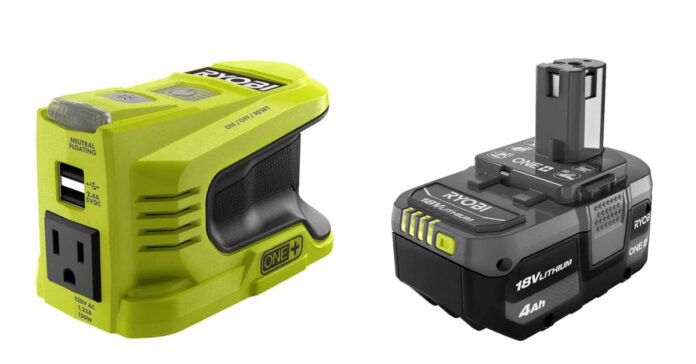I just took advantage of “Ryobi Days Deal” offer at Home Depot and bought two of their 18-volt rechargeable batteries for $99. As my free “tool” that came with the promotion, I ordered the Ryobi inverter, Like the entire line of their battery powered tools, is powered by a Ryobi One+ battery.
After this purchase arrives, I will have six of their batteries, four of which will be 4-amp hour batteries, and two smaller batteries that do not last as long.
The Inverter
The Ryobi inverter is a small thing with two USB ports and a single 120-volt AC outlet that can provide a maximum of 150 watts. In the inverter world, this is tiny. Don’t expect it to power your refrigerator, or even your toaster oven, but it can power a light, a radio, and charge anything with a USB charger. One of the 4-amp hour batteries will charge your average cell phone six times and run a floor lamp with an LED lightbulb for hours. It will also charge up the 18650 batteries in our rechargeable flashlights, lanterns, headlamps and weapon lights.
You can see how helpful this could be in a power outage that lasts a few days. If we run the generator for a couple hours in the morning and a couple hours again at night to keep our fridge and freezer cold, we could also use the generator power to charge the Ryobi batteries. Then, when the generator is off, we could use the Ryobi inverter to power a LED lamp or other light.
In a longer power outage where we run out of gas and cannot use the generator, we can use the 12-volt Ryobi charger, which is meant to be plugged into your work truck’s cigarette lighter, to charge the batteries using a small solar panel. I have two folding portable panels and one small fixed panel. It will be interesting to see if any of them can generate sufficient power to charge the Ryobi batteries.
Lighting
Although our house is all-electric, we can cook and heat on our wood stove, and our water is gravity flow, so it does not require power like a well pump. Outside of refrigeration, our primary electric needs during a short-term power outage are lighting and communication, which this mini inverter can handle. The inverter is so small it is easily portable, so we can move it from room to room and plug in a different lamp each place.
A Ryobi battery produces 72 watt-hours of power (4 x 18). That should be enough to run an 8-watt LED bulb (which is equivalent to a traditional 60-watt of light) for 8 hours, but considering power loss inherent in any inverter and the fact that the battery will cut off before it discharges too deeply, it might give us six hours of light. That’s more than enough time to extend the evening. It also makes light without the fire hazard and smell of kerosene lantern or a candle.
You can also plug a short wave radio, AM/FM or CB radio into it if you wish to have radio communications, and it is sufficiently powerful enough to charge batteries for your portable radios.
A Stop-Gap Solution
Let me be clear: I don’t think the Ryobi battery and inverter combination is the best system to use in a power outage because of its very limited output of just 150 watts. However, for a household that already has Ryobi batteries and tools, as we did, the added investment is minimal, I think it makes good sense.
Would I prefer a Bluetti or another so-called solar generator with a powerful enough inverter to run my refrigerator and a bank of solar panels to recharge it daily? Yes. But that could cost $4,000 or more. This was free. (OK, I had to spend $99 to get it for “free” but it is still an excellent price, especially when you consider I get an additional charger as well. That means I can charge up two batteries at the same time when the generator is running.)
I also have a set of yard tools that use 20-volt Black & Decker batteries. If I was desperate, I could hook them up to the inverter as well. It should be pretty easy to route power from them to the inverter using alligator clips and a couple of wires.
Another Layer
We store candles. We have at least a half-dozen kerosene lanterns and 10 gallons of kerosene. I have battery powered lamps, lanterns, head lamps, and hand-held flashlights, most of which use 18650 batteries. I have lots of batteries in many sizes. In addition to the generator, we have a 1,000-watt inverter, so don’t think we have not ignored lighting in our preps. This mini-inverter is simply another layer that we are adding in a cost-effective manner.
Expect a hand-on product review and detailed report next month.









Thanks for the tip… I went out and bought one today.
Comments are closed.